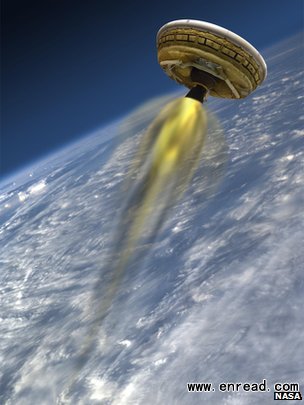|
  
- UID
- 86155
- 帖子
- 60350
- 积分
- 64892
- 学分
- 591606 个
- 金币
- 810 个
- 性别
- 男
- 在线时间
- 2779 小时

|
|
A US space agency (Nasa) experiment on Saturday to test future Mars landing technologies proved largely successful.
美国宇航局上周六进行了一次未来式火星降落实验,结果大获成功。

Artist's impression: A rocket motor was used to shoot the vehicle up through the stratosphere
A flying saucer-shaped vehicle was sent high into the atmosphere via a balloon to trial a new type of
parachute(降落伞)
and an inflatable Kevlar ring that could help slow down a spacecraft as it approaches the Red Planet's surface.
All of the equipment appeared to work apart from the parachute, which failed to deploy fully.
The experiment was sent up from Hawaii.
Nasa hopes the lessons learned will enable it put heavier payloads on Mars in the decades ahead.
The current limit is about one-and-a-half tonnes.
If humans are ever to go to the planet, this mass capability will have to rise to well beyond 10 tonnes.
Saturday's test vehicle, known as the Low Density Supersonic Decelerator (LDSD), ditched in the Pacific after its flight.
Teams were despatched to try to locate the demonstrator so that its data recorder could be recovered.
This will give engineers the most detailed information on what precisely happened during the experiment.
Video cameras on the ground and on the LDSD captured most of the flight.
The helium balloon was launched from the US Navy's Pacific Missile Range Facility in Kauai at just after 08:40 local time.
It took over two hours to raise the saucer-shaped vehicle to roughly 35km, whereupon it was released.
A rocket motor then kicked the LDSD on up through the stratosphere to above 50km, and to a velocity of Mach 4 (four times the speed of sound) - the sort of conditions a spacecraft approaching Mars might encounter.
As the vehicle began to slow, it deployed the first of its two new atmospheric braking systems.
This first system was a 6m inflatable "doughnut". It enlarged the LDSD's girth and so will have slowed the saucer further by increasing the amount of drag it experienced.
The second braking system, however, did not come out properly.
Upward-looking video showed the 30m-diameter supersonic parachute failing to unfurl correctly.
Nasa engineers said before the test that they would gather valuable data whether the technologies on the LDSD worked properly or not.
The project hopes to return to Hawaii next year to conduct two further test flights.
更多英语新闻 |
|